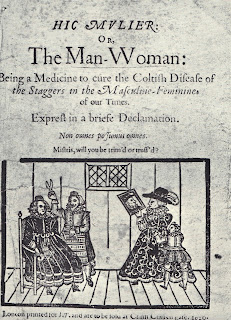 I haven’t blogged for
quite a while as I have been writing a paper which I gave last weekend. I’ve put a somewhat
reworked section of it below. People have always complained about fashion
whether it is Suetonius carping about Caligula’s dress in the first century, or
the Winchester Psalter of about 1150 depicting the devil in a tightly laced
woman’s dress, with the extraordinarily long sleeves of the period that had a
knot tied in them to keep them off the ground. At the end of the sixteenth
century and the beginning of the seventeenth century most of these complaints
came from “puritans”. There were a lot of pamphlets published at this time, and
in particular a lot of complaints about women “aping” men’s wear.
I haven’t blogged for
quite a while as I have been writing a paper which I gave last weekend. I’ve put a somewhat
reworked section of it below. People have always complained about fashion
whether it is Suetonius carping about Caligula’s dress in the first century, or
the Winchester Psalter of about 1150 depicting the devil in a tightly laced
woman’s dress, with the extraordinarily long sleeves of the period that had a
knot tied in them to keep them off the ground. At the end of the sixteenth
century and the beginning of the seventeenth century most of these complaints
came from “puritans”. There were a lot of pamphlets published at this time, and
in particular a lot of complaints about women “aping” men’s wear.
Three of the specific
items of complaint were picked up in January of 1620 by the letter writer John
Chamberlain (1553-1628), who was no puritan but a moderate in matters of
religion. He said that the Bishop of London had been told
by the King (James I) to get his clergy to preach against “The insolence of our
women and their wearing of broad brimmed hats, pointed doublets, their hair cut
short or shorn” The anonymous author of Hic-Mulier or the Man-woman, published
in February 1620 by John Trundle (1575-1629), picked up on these as you can see
from the title page. The cartoon says “Mistress will you be trimmed or trussed.” Trimming in the cartoon refers to women
cutting their hair short, and trussing to their adoption of something vaguely
resembling a man’s doublet. Men’s doublets were trussed to their breeches.
 |
| Henrietta Maria by Van Dyck, 1633 |
In Hic Mulier the author
says “You have take the monstrousness of your deformity in apparel, exchanging
the modest attire of the comely hood, caul, coif, handsome dress or kerchief.
To the cloudy, ruffianly broad brimmed hat and wanton feather, the modest upper
parts of a concealing straight gown, to the loose, lascivious civil embracement
of a French doublet, being all unbuttoned to entice, all of one shape to hide
deformity, and extreme short waisted, to give a most easy way to every
luxurious action; the glory of fair large hair to the shame of most ruffianly
short locks.” So what did this aping of men’s wear look like in practice? Well
a good example is probably this portrait of Queen Henrietta Maria painted by
Van Dyck in 1633. Here you see the broad brimmed hat, trimmed with a “wanton”
feather, the short hair style, and a front opening bodice cut with tabs like a
man’s doublet.
In his 1628 work The unloveliness of lovelocks,
which is having a go at men with long hair, William Prynne (1600-1669) also complains
that women were becoming shameless and immodest. He speaks of “the mannish
viragoes, or audacious men-women [who] do unnaturally clip and cut their hair.”
and says “in the unnatural tonsure and odious if not whoreish cutting and
crisping of their hair, their natural vaile, their feminine glory and the very
badge and character of their subjection both to God and man” I suspect that
this last comment is what is worrying some men at the time, that women are
forgetting their supposed subjugation to man.
No comments:
Post a Comment
Note: only a member of this blog may post a comment.